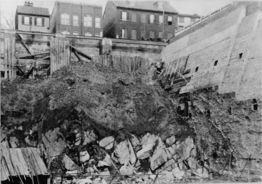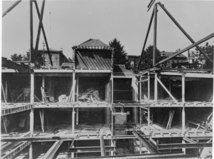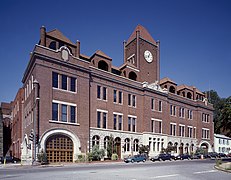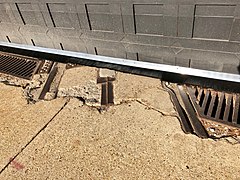
Georgetown is a historic neighborhood and commercial district in Northwest Washington, D.C., situated along the Potomac River. Founded in 1751 as part of the colonial-era Province of Maryland, Georgetown predated the establishment of Washington, D.C. by 40 years. Georgetown was an independent municipality until 1871 when the United States Congress created a new consolidated government for the entire District of Columbia. A separate act, passed in 1895, repealed Georgetown's remaining local ordinances and renamed Georgetown's streets to conform with those in Washington, D.C..

Glen Echo Park is an arts and cultural center in Glen Echo, Maryland, a suburb of Washington, D.C. Located about 9 miles (14 km) northwest of the city's downtown area, the park's site was initially developed in 1891 as a National Chautauqua Assembly.

Streetcars in Washington, D.C. transported people across the city and region from 1862 until 1962.

The M-Line Trolley is a heritage streetcar line in the Uptown neighborhood of Dallas, Texas. The trolley line, which has been in service since 1989, is notable for its use of restored historic streetcar vehicles, as opposed to modern replicas.

The Rock Creek Railway, which operated independently from 1890 to 1895, was one of the first electric streetcar companies in Washington, D.C., and the first to extend into Maryland.

Pittsburgh Railways was one of the predecessors of Pittsburgh Regional Transit. It had 666 PCC cars, the third largest fleet in North America. It had 68 streetcar routes, of which only three are used by the Port Authority as light rail routes. With the Port Authority's Transit Development Plan, many route names will be changed to its original, such as the 41D Brookline becoming the 39 Brookline. Many of the streetcar routes have been remembered in the route names of many Port Authority buses.

The National Capital Trolley Museum (NCTM) is a 501(c)(3) nonprofit organization that operates historic street cars, trolleys and trams for the public on a regular schedule. Located in Montgomery County, Maryland, the museum's primary mission is to preserve and interpret the history of the electric street and interurban railways of the National Capital region.
Oscar Roy Chalk was a New York entrepreneur who owned real estate, airlines, bus companies, newspapers and a rail line that hauled bananas in Central America. His diverse holdings included DC Transit, Trans Caribbean Airways, the Houdon bust of Thomas Jefferson now at Monticello, the Chalk Emerald, and the New York Spanish-language newspapers El Diario de Nueva York and La Prensa, merging them into El Diario La Prensa.

Streetcars and interurbans operated in the Maryland suburbs of Washington, D.C., between 1890 and 1962.
The Capital Traction Company was the smaller of the two major street railway companies in Washington, D.C., in the early 20th century.
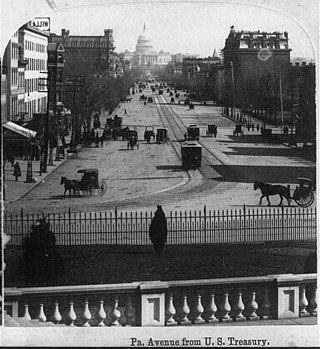
The Washington and Georgetown Railroad Company was the first streetcar company to operate in Washington, D.C., United States. It was incorporated and started operations in 1862, using horse-drawn cars on tracks between Georgetown and the Navy Yard. Two additional lines ran on 7th Street NW/SW and 14th Street NW. In 1890, it switched to cable cars. On September 21, 1895, the company was purchased by the Rock Creek Railway and the two formed the Capital Traction Company.
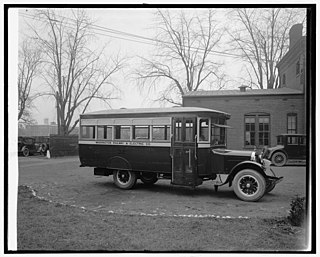
The Washington Railway and Electric Company (WRECo) was the larger of the two major streetcar companies in Washington, D.C., and its Maryland suburbs in the early decades of the 20th century.

The Metropolitan Railroad was the second streetcar company to operate in Washington, D.C., the capital city of the United States. It was incorporated and started operations in 1864, running from the Capitol to the War Department and along H Street NW in downtown. It added lines on 9th Street NW, on 4th Street SW/SE, along Connecticut Avenue to Dupont Circle, to Georgetown, to Mount Pleasant and north along Georgia Avenue. In the late 19th century, it was purchased by the Washington Traction and Electric Company and on February 4, 1902, became a part of the Washington Railway and Electric Company.

The Houghton County Traction Company Ahmeek Streetcar Station is a rail station located at the corner of US 41/M-26 and Hubbell Street in Ahmeek, Michigan. It was listed on the National Register of Historic Places in 2000.

DC USA is an 890,000-square-foot (83,000 m2) vertical power center, i.e. a multilevel enclosed urban shopping center anchored by big box stores. It is located in the Columbia Heights neighborhood of Washington, D.C. A Washington City Paper poll named DC USA the "Best Designed Retail Space" of 2009. The development is adjacent to the Columbia Heights station on the Green Line of the Washington Metro. It is also served by eight bus routes and has a 1,000-space parking garage.
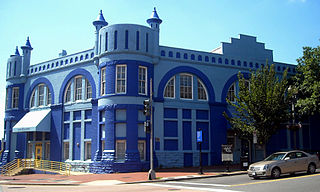
The Washington and Georgetown Railroad Car House, also known as the Navy Yard Car Barn, or Blue Castle, is an historic building, located at 770 M Street, Southeast, Washington, D.C.

Prospect House is a historic building, located at 3508 Prospect Street, Northwest, Washington, D.C., in the Georgetown neighborhood.

The Exorcist steps are concrete stairs, continuing 36th Street, descending from the corner of Prospect St and 36th St NW, down to a small parking lot, set back from the intersection of M Street NW, Canal Rd NW, and Whitehurst Freeway NW in the Georgetown neighborhood of Washington, D.C., famous for being featured in the 1973 film The Exorcist. The steps were built in 1895 by George Killeen, a prominent local Democratic figure, during construction of the adjacent Capital Traction Company Barn for cable cars, serving as a lightwell and public right of way. There is a family legend of Geroge Killeen that the wall's construction was a handshake agreement and that Killeen was never paid for its completion. Before the Exorcist association, the stairs were informally called "Hitchcock steps" for famed suspense and horror film director Alfred Hitchcock.

The Capital Traction Company Car Barn is a historic streetcar car barn in northwest Washington, D.C. Built in 1906 by the Capital Traction Company, it was later turned into a bus garage and is currently owned by Washington Metropolitan Area Transit Authority.
A trio of streetcar companies provided service along a single 10-mile line from the Washington, D.C., neighborhood of Georgetown northward and ultimately to Rockville, Maryland, in the early decades of the 20th century.


